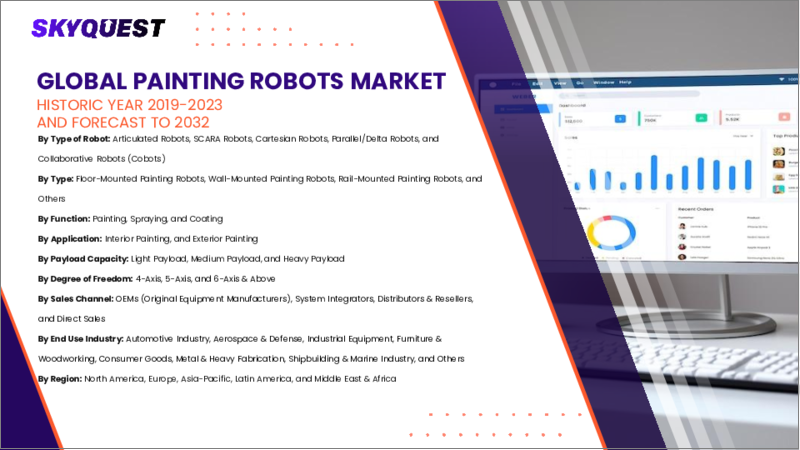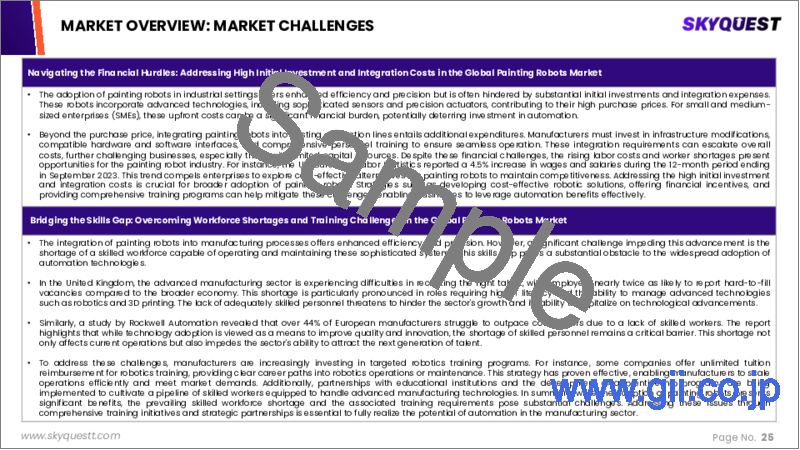|
|
市場調査レポート
商品コード
1630713
塗装ロボットの市場規模、シェア、成長分析、タイプ別、機能別、用途別、エンドユーザー別、地域別 - 産業予測 2025~2032年Painting Robots Market Size, Share, Growth Analysis, By Type (Floor-Mounted Painting Robots, Wall-Mounted Painting Robots), By Function (Painting, Spraying), By Application, By End-User, By Region - Industry Forecast 2025-2032 |
||||||
|
|||||||
| 塗装ロボットの市場規模、シェア、成長分析、タイプ別、機能別、用途別、エンドユーザー別、地域別 - 産業予測 2025~2032年 |
|
出版日: 2025年01月09日
発行: SkyQuest
ページ情報: 英文 195 Pages
納期: 3~5営業日
|
全表示
- 概要
- 目次
塗装ロボットの世界市場規模は、2023年に45億米ドルと評価され、2024年の49億2,000万米ドルから2032年には100億2,000万米ドルに成長し、予測期間(2025-2032年)のCAGRは9.3%で成長する見通しです。
自動車産業の需要拡大がロボット設計市場を大きく牽引する見通しです。この急増は、経済成長、生活水準の向上、購買力の改善などが自動車需要の増加を後押ししていることに起因しています。特に、世界の自動車製造は1.3%の成長を遂げ、2021年には7,910万台に達し、電気自動車の販売台数は85%急増します。自動車メーカーが効率と精度を追求するなか、無駄を最小限に抑えるロボット・グラフィックスの必要性が重要になっています。同時に、人件費の高騰により、企業は競争力を強化するため、特に塗装工程で費用対効果の高い自動化ソリューションを模索せざるを得なくなっています。効率的な生産方法の追求がますます急務になっていることは、自動車セクターの幅広い動向を反映し、ロボットデザイン市場の力強い成長の可能性を強調しています。
目次
イントロダクション
- 調査の目的
- 調査範囲
- 定義
調査手法
- 情報調達
- 二次データと一次データの方法
- 市場規模予測
- 市場の前提条件と制限
エグゼクティブサマリー
- 世界市場の見通し
- 供給と需要の動向分析
- セグメント別機会分析
市場力学と見通し
- 市場概要
- 市場規模
- 市場力学
- 促進要因と機会
- 抑制要因と課題
- ポーターの分析
主な市場の考察
- 重要成功要因
- 競合の程度
- 主な投資機会
- 市場エコシステム
- 市場の魅力指数(2024年)
- PESTEL分析
- マクロ経済指標
- バリューチェーン分析
- 価格分析
- ケーススタディ
- 技術の進歩
- 規制情勢
- 特許分析
塗装ロボット市場規模:タイプ別
- 市場概要
- 床置き型塗装ロボット
- 壁掛け型塗装ロボット
- レール搭載型塗装ロボット
- その他
塗装ロボット市場規模:機能別
- 市場概要
- 塗装
- スプレー
- コーティング
塗装ロボット市場規模:用途別
- 市場概要
- 室内塗装
- 外装塗装
塗装ロボット市場規模:エンドユーザー別
- 市場概要
- 自動車
- 自動車製造
- トラック製造
- 航空宇宙
- 航空機製造
- 宇宙船製造
- 建設
- 住宅
- 商業ビル
- その他
- 家具製造
- 電子機器製造
塗装ロボット市場規模
- 北米
- 米国
- カナダ
- 欧州
- ドイツ
- スペイン
- フランス
- 英国
- イタリア
- その他欧州地域
- アジア太平洋地域
- 中国
- インド
- 日本
- 韓国
- その他アジア太平洋地域
- ラテンアメリカ
- ブラジル
- その他ラテンアメリカ地域
- 中東・アフリカ
- GCC諸国
- 南アフリカ
- その他中東・アフリカ
競合情報
- 上位5社の比較
- 主要企業の市場ポジショニング(2024年)
- 主な市場企業が採用した戦略
- 市場の最近の動向
- 企業の市場シェア分析(2024年)
- 主要企業の企業プロファイル
- 会社概要
- 製品ポートフォリオ分析
- セグメント別シェア分析
- 収益の前年比比較(2022-2024)
主要企業プロファイル
- ABB Ltd.(Switzerland)
- FANUC Corporation(Japan)
- Yaskawa Electric Corporation(Japan)
- Kawasaki Heavy Industries, Ltd.(Japan)
- Durr AG(Germany)
- Epson Robots(Seiko Epson Corporation)(Japan)
- Staubli International AG(Switzerland)
- Comau S.p.A.(Italy)
- Nachi-Fujikoshi Corp.(Japan)
- Universal Robots A/S(Denmark)
- Omron Corporation(Japan)
- Siasun Robot & Automation Co., Ltd.(China)
- Hyundai Robotics(South Korea)
- Mitsubishi Electric Corporation(Japan)
- Techman Robot Inc.(Taiwan)
- Denso Corporation(Japan)
- Rockwell Automation, Inc.(USA)
- Bosch Rexroth AG(Germany)
- Toshiba Machine Co., Ltd.(Japan)
結論と推奨事項
Global Painting Robots Market size was valued at USD 4.5 billion in 2023 and is poised to grow from USD 4.92 billion in 2024 to USD 10.02 billion by 2032, growing at a CAGR of 9.3% during the forecast period (2025-2032).
The automotive industry's escalating demand is poised to significantly propel the robotic design market. This surge stems from economic growth, enhanced living standards, and improved purchasing power, all driving higher automotive demand. Notably, global automotive manufacturing experienced a 1.3% growth, reaching 79.1 million vehicles in 2021, with electric vehicle sales soaring by 85%. As automakers strive for efficiency and precision, the need for robotic graphics to minimize waste is becoming critical. Concurrently, rising labor costs are compelling organizations to explore cost-effective automation solutions, particularly in painting processes, to bolster competitiveness. The increasingly urgent quest for efficient production methods underscores the robust growth potential within the robotic design market, mirroring broader trends in the automotive sector.
Top-down and bottom-up approaches were used to estimate and validate the size of the Global Painting Robots market and to estimate the size of various other dependent submarkets. The research methodology used to estimate the market size includes the following details: The key players in the market were identified through secondary research, and their market shares in the respective regions were determined through primary and secondary research. This entire procedure includes the study of the annual and financial reports of the top market players and extensive interviews for key insights from industry leaders such as CEOs, VPs, directors, and marketing executives. All percentage shares split, and breakdowns were determined using secondary sources and verified through Primary sources. All possible parameters that affect the markets covered in this research study have been accounted for, viewed in extensive detail, verified through primary research, and analyzed to get the final quantitative and qualitative data.
Global Painting Robots Market Segmental Analysis
Global Painting Robots Market is segmented by Type, Function, Application, End-User and region. Based on Type, the market is segmented into Floor-Mounted Painting Robots, Wall-Mounted Painting Robots, Rail-Mounted Painting Robots and Others. Based on Function, the market is segmented into Painting, Spraying and Coating. Based on Application, the market is segmented into Interior Painting and Exterior Painting. Based on End-User, the market is segmented into Automotive, Aerospace, Construction and Others. Based on region, the market is segmented into North America, Europe, Asia Pacific, Latin America and Middle East & Africa.
Driver of the Global Painting Robots Market
The global market for painting robots is significantly influenced by the growing integration of automation technologies and the principles of Industry 4.0 across multiple sectors. This trend is propelling the demand for robotic systems, as these advanced machines enhance precision, durability, and overall efficiency in manufacturing processes. By streamlining operations, painting robots contribute to substantial cost reductions and improved productivity within various industries. As businesses increasingly seek innovative solutions to optimize their workflows, the market for painting robots is poised to expand further, signifying a pivotal shift towards automation and modernization in manufacturing practices.
Restraints in the Global Painting Robots Market
One of the significant constraints in the Global Painting Robots market is the substantial initial investment required for both the purchase and operation of these robotic systems. This financial burden can be particularly challenging for small and medium-sized enterprises (SMEs), making it difficult for them to adopt this technology. The elevated upfront costs create a barrier to entry, limiting the market's expansion and preventing many potential users from exploring the advantages that painting robots offer. As a result, the high investment requirement poses a notable challenge to the widespread incorporation of painting robots across various sectors.
Market Trends of the Global Painting Robots Market
The global painting robots market is witnessing a notable trend toward the emergence of collaborative design robots, which are engineered to operate alongside human workers in integrated workspaces. This shift focuses on enhancing flexibility, safety, and seamless integration into existing manufacturing processes, thereby streamlining operations and boosting productivity. Businesses are increasingly adopting these collaborative solutions to harness the advantages of advanced technology while retaining the creative input of human operators. As industries prioritize efficiency and innovation, the demand for painting robots that can collaboratively enhance design workflows is expected to accelerate, shaping the future landscape of automation in manufacturing.
Table of Contents
Introduction
- Objectives of the Study
- Scope of the Report
- Definitions
Research Methodology
- Information Procurement
- Secondary & Primary Data Methods
- Market Size Estimation
- Market Assumptions & Limitations
Executive Summary
- Global Market Outlook
- Supply & Demand Trend Analysis
- Segmental Opportunity Analysis
Market Dynamics & Outlook
- Market Overview
- Market Size
- Market Dynamics
- Drivers & Opportunities
- Restraints & Challenges
- Porters Analysis
- Competitive rivalry
- Threat of substitute
- Bargaining power of buyers
- Threat of new entrants
- Bargaining power of suppliers
Key Market Insights
- Key Success Factors
- Degree of Competition
- Top Investment Pockets
- Market Ecosystem
- Market Attractiveness Index, 2024
- PESTEL Analysis
- Macro-Economic Indicators
- Value Chain Analysis
- Pricing Analysis
- Case Studies
- Technology Advancement
- Regulatory Landscape
- Patent Analysis
Global Painting Robots Market Size by Type & CAGR (2025-2032)
- Market Overview
- Floor-Mounted Painting Robots
- Wall-Mounted Painting Robots
- Rail-Mounted Painting Robots
- Others
Global Painting Robots Market Size by Function & CAGR (2025-2032)
- Market Overview
- Painting
- Spraying
- Coating
Global Painting Robots Market Size by Application & CAGR (2025-2032)
- Market Overview
- Interior Painting
- Exterior Painting
Global Painting Robots Market Size by End-User & CAGR (2025-2032)
- Market Overview
- Automotive
- Car Manufacturing
- Truck Manufacturing
- Aerospace
- Aircraft Manufacturing
- Spacecraft Manufacturing
- Construction
- Residential Buildings
- Commercial Buildings
- Others
- Furniture Manufacturing
- Electronics Manufacturing
Global Painting Robots Market Size & CAGR (2025-2032)
- North America (Type, Function, Application, End-User)
- US
- Canada
- Europe (Type, Function, Application, End-User)
- Germany
- Spain
- France
- UK
- Italy
- Rest of Europe
- Asia Pacific (Type, Function, Application, End-User)
- China
- India
- Japan
- South Korea
- Rest of Asia-Pacific
- Latin America (Type, Function, Application, End-User)
- Brazil
- Rest of Latin America
- Middle East & Africa (Type, Function, Application, End-User)
- GCC Countries
- South Africa
- Rest of Middle East & Africa
Competitive Intelligence
- Top 5 Player Comparison
- Market Positioning of Key Players, 2024
- Strategies Adopted by Key Market Players
- Recent Developments in the Market
- Company Market Share Analysis, 2024
- Company Profiles of All Key Players
- Company Details
- Product Portfolio Analysis
- Company's Segmental Share Analysis
- Revenue Y-O-Y Comparison (2022-2024)
Key Company Profiles
- ABB Ltd. (Switzerland)
- Company Overview
- Business Segment Overview
- Financial Updates
- Key Developments
- FANUC Corporation (Japan)
- Company Overview
- Business Segment Overview
- Financial Updates
- Key Developments
- Yaskawa Electric Corporation (Japan)
- Company Overview
- Business Segment Overview
- Financial Updates
- Key Developments
- Kawasaki Heavy Industries, Ltd. (Japan)
- Company Overview
- Business Segment Overview
- Financial Updates
- Key Developments
- Durr AG (Germany)
- Company Overview
- Business Segment Overview
- Financial Updates
- Key Developments
- Epson Robots (Seiko Epson Corporation) (Japan)
- Company Overview
- Business Segment Overview
- Financial Updates
- Key Developments
- Staubli International AG (Switzerland)
- Company Overview
- Business Segment Overview
- Financial Updates
- Key Developments
- Comau S.p.A. (Italy)
- Company Overview
- Business Segment Overview
- Financial Updates
- Key Developments
- Nachi-Fujikoshi Corp. (Japan)
- Company Overview
- Business Segment Overview
- Financial Updates
- Key Developments
- Universal Robots A/S (Denmark)
- Company Overview
- Business Segment Overview
- Financial Updates
- Key Developments
- Omron Corporation (Japan)
- Company Overview
- Business Segment Overview
- Financial Updates
- Key Developments
- Siasun Robot & Automation Co., Ltd. (China)
- Company Overview
- Business Segment Overview
- Financial Updates
- Key Developments
- Hyundai Robotics (South Korea)
- Company Overview
- Business Segment Overview
- Financial Updates
- Key Developments
- Mitsubishi Electric Corporation (Japan)
- Company Overview
- Business Segment Overview
- Financial Updates
- Key Developments
- Techman Robot Inc. (Taiwan)
- Company Overview
- Business Segment Overview
- Financial Updates
- Key Developments
- Denso Corporation (Japan)
- Company Overview
- Business Segment Overview
- Financial Updates
- Key Developments
- Rockwell Automation, Inc. (USA)
- Company Overview
- Business Segment Overview
- Financial Updates
- Key Developments
- Bosch Rexroth AG (Germany)
- Company Overview
- Business Segment Overview
- Financial Updates
- Key Developments
- Toshiba Machine Co., Ltd. (Japan)
- Company Overview
- Business Segment Overview
- Financial Updates
- Key Developments






